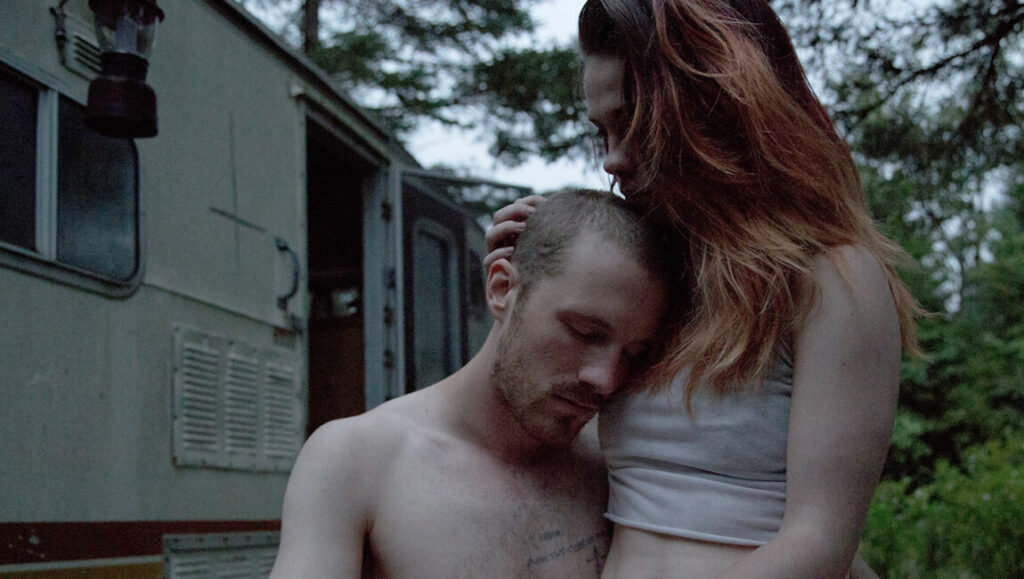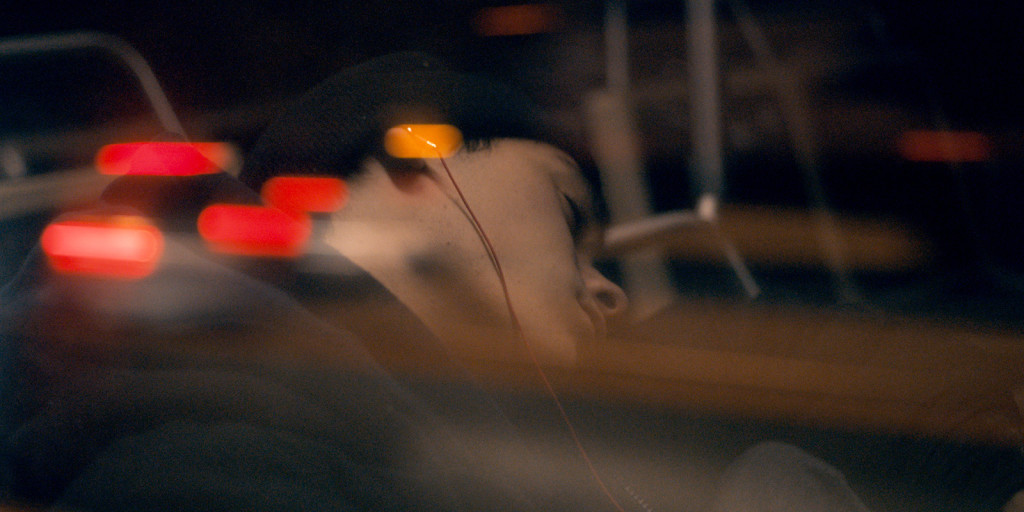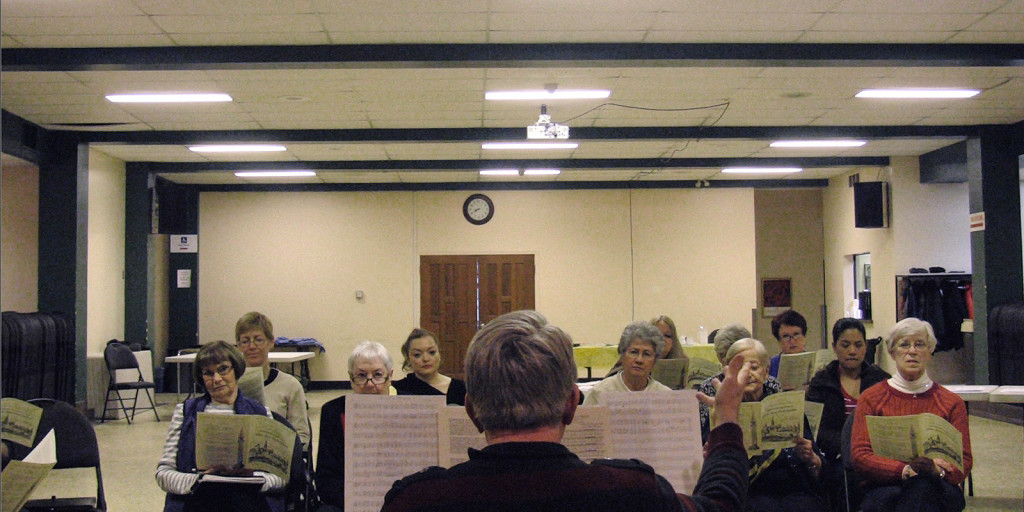One of the most exciting developments of this year’s Vancouver International Film Festival was the introduction of Future // Present, a program focused on new films from emerging Canadian filmmakers. Curated by critic and programmer Adam Cook, the eight films shown—from predominantly first-time feature filmmakers—were diverse in form and content, ranging from narrative fiction, to documentary, mockumentary, docu-fiction, and more. It’s not often that work from bold new Canadian directors is grouped together in a single place, but Future // Present did precisely that. This piece surveys the eight feature films, as well as the shorts, that made up this inaugural selection.
It’s often a fool’s errand to go searching for themes in a given festival program, but if there’s a common thread running through Future // Present, it’s the concept of home. The Intestine—Lev Lewis’s slippery, fascinating feature debut—centers on Maya (Melanie Scheiner), a young woman working a dead-end job while also looking after her junkie mother. After finding herself alone in an enormous, tastefully decorated suburban mansion the day after an (elided) one-night stand, she decides to luxuriate in the residence, even passing herself off as the owner to a new neighbor. It’s a clever hook, complemented nicely by Scheiner’s beguilingly opaque performance. The Intestine is also (to Lewis’s credit) fairly difficult to categorize in the early going. (Cronenbergian body horror? Egoyanesque grief ritual?) Distilling or classifying the plot isn’t entirely useful anyway, especially since it’s Lewis’s formal prowess and confident narrative gamesmanship that compels most here. Employing an insistent, effective score and slow, sinuous camera movements, The Intestine communicates a sharp sense of dislocation; it’s a portrait of a woman confused and adrift, her already-tenuous situation shaken by her mother’s abrupt death (likely by heroin overdose) and the events at the mansion. There are a lot of stray details—often conveyed in distinctive low-light compositions—that are left (refreshingly) unexplained, but that still work on an intuitive level. “I want a home,” says Maya late in the film—and even if Lewis’s response to this becomes fairly predictable, particularly in The Intestine’s latter half, his confident direction is more than enough to compensate.
In co-directors Nicolas Lachapelle and Ariel St-Louis Lamoureux’s first feature, a Cree child from Waswanipi, Quebec says of her home, “It’s not a village—it’s a community.” Unlike most films described as “slice-of-life,” Lights Above Water fits the label: It simply follows a group of children as they roam through their community, observing them sneak past fences, buy bags of Doritos at a convenience store, and frolic in a backyard pool on a summer day. Alternating between tender observational moments and scenes of gorgeous abstraction, Lights Above Water becomes a far more eloquent portrait of (First Nations) marginalization than its logline might indicate, more effective for the way it keeps the implicit issue’s treatment oblique. There’s a fireworks display towards the end that explains the title, but it’s the children of Waswanipi that really fulfill it—keeping their heads above water, they remain radiant and resoundingly alive.
Accompanying Lights Above Water, Two, a 13-minute experimental short directed by Christopher Spencer-Lowe, was shot entirely on Super 8 film. Two is like a home movie crossed with an avant-garde film—and as well an exploration of the limitations and boundaries of both. The grainy, personal images come in a flurry, accompanied by voiceover from Spencer-Lowe’s principle subject: a two-year-old child named Harley. This is a film assembled from the flotsam and jetsam of authentic experience and artistic contrivance—a snapshot of childhood filtered through an explicit act of documentation.
It’s not childhood, but adolescence that lies at the heart of The Lockpicker, directed by visual artist and short filmmaker Randall Okita. Favoring gorgeous impressionism over studied story beats (though it has a few of those as well), the film follows Hashi (Keigian Umi Tang), a solitary teenage boy reeling from the recent suicide of a friend. Okita’s film definitely moves towards a clear narrative endpoint, but it’s Hashi’s transition—both spatial and emotional—that interests most. Scenes are soundtracked by recorded conversations (some crucial, others of an everyday sort) that Hashi perpetually carries with him, and presented in a glancing editing style. At key points, the flow is punctuated by striking, dreamlike interludes that slowly bleed into reality, until a startling act of violence becomes an irreversible turning point. Throughout, lead actor Keigian Umi Tang alters the tenor of his performance to suit Hashi’s own shifting, unsure identity, moving from the playful ease of the scenes with his sister to the shy tenderness of those with the co-worker he likes, to studied sullenness at school (where he also engages in petty thievery). In the vein of something like Gus Van Sant’s Paranoid Park, the film maps the psychological space of adolescence with acuity, capturing the frightening enormity of the experience with a perspective that’s both steely and tender. The impressionistic final image is of receding city lights, obscured by trees and the orange glow of lonely street lamps, from the vantage point of a moving bus. This is a portrait of adolescence as fragmented dislocation, as destabilizing flux.
Known for his experimental work, Karl Lemieux makes his narrative feature debut with Maudite Poutine, which follows a drummer named Vincent (Jean-Simon Leduc) as he and his fellow bandmates deal with the consequences of stealing some pot from a violent gang of local dealers. Opening with these repercussions already in motion, the film observes Vincent’s attempts to scrape together reimbursement money, which is complicated slightly by the effort of his older junkie brother (Martin Dubreuil) to help. The scant narrative builds towards climactic moments of sacrifice and violent release, but the film seems more a pretext for Lemieux to capture the various spaces of Vincent’s life in stunning, high-contrast black and white cinematography. Gorgeous compositions chart the rather wan (somewhat contrived) story with genuine flair, making maximum use of various locales and events (a looming factory space; a noisy concert) to play with light and shadow in ways that engage in spite of the narrative material. These images linger long after the specifics of story have faded.
Matthew Taylor Blais‘s Popsong forgoes any and all narrative: An entirely silent, three-minute experimental short, it was made by layering images in such a way that each cancels out the other, the frames becoming mostly black, negative space. But because there’s a delay between the images, this also creates vibrant bursts of color. The effect isn’t a literalization of Popsong‘s title so much as it is a unique cinematic translation of that idea.
Recent Emerging Canadian Director award-winner Sofia Bohdanowicz‘s debut feature played Future // Present alongside a trilogy of earlier shorts from 2013. Bearing the influence of Chantal Akerman, the three shorts, all filmed in the home of Bohdanowicz’s paternal grandmother, are both rigorously composed and remarkably personal. The first, Modlitwa (A Prayer), is a domestic study of Bohdanowicz’s grandmother, made shortly before she was diagnosed with terminal cancer. The second and third, made following her death, revisit the now-empty house and morph the project into something quite different. Wieczór (An Evening) observes the vacant spaces and left behind objects over a single night, the images shot in a fading light and accompanied by a looped but ever-slowing record. The final entry, Dalsza Modlitwa (Another Prayer), literally revisits the first by projecting the original footage of Modlitwa onto the various spaces of the house. Individually, the films are compelling—but together, they accumulate a surprising emotional force. What starts out as a simple look at domestic life, gradually becomes a moving meditation on not just mortality, but also the infinite accumulations of a life lived and left behind.
Never Eat Alone, a documentary-fiction hybrid and Bohdanowicz’s first feature, is an elegant extension of the trilogy’s themes of loss, memory and connection. There’s a loose narrative built around an elderly widow (played by her maternal grandmother) reminiscing about a former lover with whom she worked on a television show in the 1950s, and the attempts her granddaughter in the film (Deragh Campbell) makes to find them and re-connect the two. But Never Eat Alone doesn’t place as much emphasis on the overarching story as on the accretion of personal, everyday choices that occur over time. The film is both understated and observational, and while it doesn’t necessarily build towards a particular endpoint, its final moments—a grandmother’s memory of her granddaughter’s first communion—are moving all the same.
If Bohdanowicz’s film explores the porous border between fiction and reality, Lawrence Coté-Collins’s mockumentary Split actively bulldozes it. Framed as a documentary about social reintegration after prison, the film follows Scott (Ronald Cyr), an ex-inmate, and Jessie (Whitney Lafleur), his vivacious young wife. As the shoot goes on, the documentarian (and social worker) Anick (Marjolaine Beauchamp) becomes more and more entangled in the couple’s lives; Coté-Collins’s film could be read as an exploration of documentary ethics. Various scenes, especially ones that invade the couple’s privacy, are meant to unsettle the viewer and push the bounds of what we are comfortable with seeing, but Split works just as well (if not better) as a look at the nature of performance. Indeed, the mockumentary’s best moments simply showcase lead actress Whitney Lafleur’s captivating presence as Jessie. Her “impromptu” lip sync dance routine is a joyous showstopper of a scene, one of the most purely enjoyable moments of any film at VIFF this year. Split may not be brimming with new insight, but Coté-Collins and Lafleur inject enough lively energy to make it worthwhile.
Less concerned with story than with the very act of storytelling is Andrea Bussmann‘s and Nicolas Pereda‘s (aptly titled) Tales of Two Who Dreamt. Taking place entirely in a housing block on the fringes of Toronto, the film centers on an immigrant family awaiting their residency status (after having sold their house in Hungary to move to Canada). Presented as tenement fiction crossed with a making-of documentary, the film tells various stories from the housing block, the main one about a young boy who finds himself transformed into a giant bird. Throughout, the stories are framed by the filmmaking process, but with the actual telling—scenes staged or actual footage—frequently hampered by the banal intrusions of daily life. A film subplot in which objects are moved into a little boy’s room is displaced by an attempt to fit a faulty fridge through the kitchen door. A shoot is stalled by the logistics of an immigration interview. (“It’s a lot of waiting around,” says one woman of the filmmaking process.) Bussmann’s and Pereda’s approach is both a canny conceit and a wry reversal: The various stories find strangenesses in the everyday, but the fictions themselves are overwhelmed by the mundane. Although the film isn’t quite as effective as that approach would indicate, both directors certainly commit to that vision. Like the titular couple awaiting their residency status, Tales of Two Who Dreamt is a film caught in limbo, adrift in the space between dreams and reality.
As its title suggests, transformation is the subject of Ashley McKenzie’s feature debut, Werewolf—a film that is at once empathetic and unsentimental. McKenzie follows Blaise (Andrew Gillis) and Nessa (Bhreagh MacNeil), a methadone-dependent couple, as they navigate the myriad travails of daily life in the director’s native Cape Breton. At the mercy of both housing and healthcare bureaucracy, and dependent on the kindness of strangers and friends, the two attempt the Sisyphean task of simply scraping by. All the while, they tug along a lawnmower with which they attempt to make some money. But their central relationship becomes its own source of stagnation; so when Nessa attempts to move forward, the tenuous cords of their relationship begin to strain. (“It can be threatening when one person changes,” a social worker tells her.) If the dramatic arc feels overly familiar, it’s the details, frequently lensed in expressive close-ups and accompanied by an intensely (and effectively) modulated score, that make the difference. Throughout, McKenzie employs a canny visual scheme, often dividing the image into horizontal and vertical planes, with Blaise and Nessa pushed to the edge of the frame, dominated by negative space and shut out by layers of pristine glass and cold bureaucracy. There’s also a visual fragmentation at play, the cycles of addiction and poverty practically driving their bodies to primal—even feral—need. It’s to McKenzie’s credit that despite some conventional beats, the final scenes remain intensely moving, at once liberating and tragic. The ambivalent closing image in particular—of Nessa, now on the other side of those pristine glass surfaces—offers no easy release.






Comments are closed.